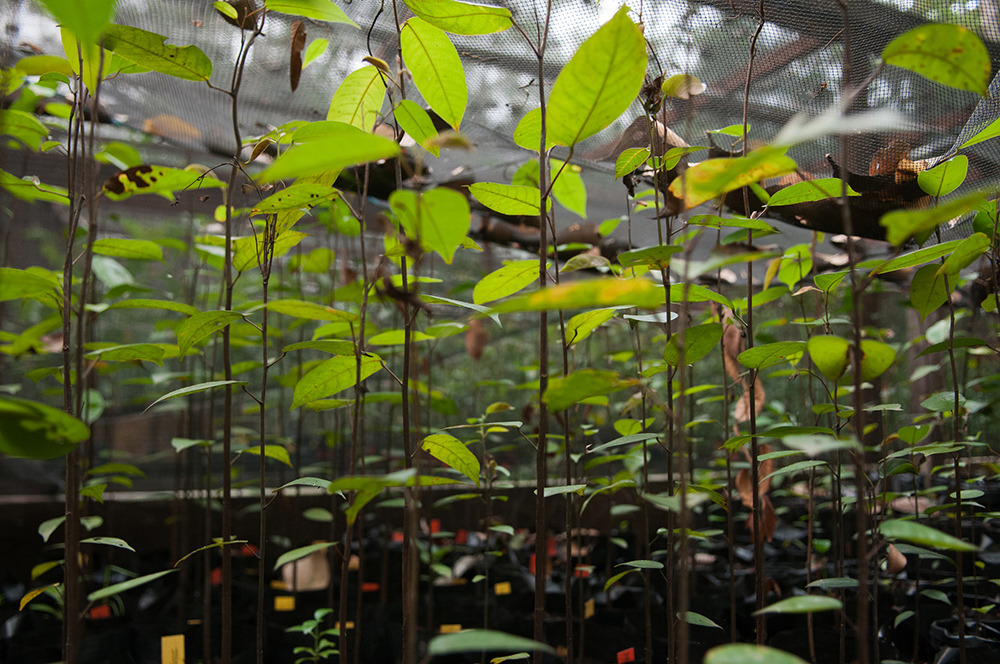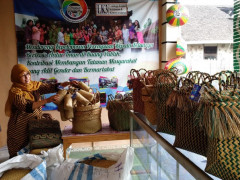Maintaining Local Wisdom While Implementing Regulations: Polemics of Clearing Land by Burning
By Pantau GambutThe Peat Restoration Commitment in Concession in Riau is Being Questioned

Based on Pantau Gambut and Kaliptra Andalas’ monitoring of the concession area revealed that some concession holders have not carried out restoration and re-planting activities in the burnt areas.
Pantau Gambut and Kaliptra Andalas closely inspected the peat restoration activities in 11 out of the 52 oil palm companies and Industrial Plantation Forests (HTI) in Riau. The findings were presented in an information dissemination session in Pekanbaru at the end of February. The three main monitoring objects are the extent to which the restoration plans in the infrastructure sector, fire analysis, and new land clearing in their concessions have been realized.
Kaliptra Andalas and Pantau Gambut have just completed field monitoring to evaluate the progress of the restoration program implemented by 11 concession holders in Riau Province. The monitoring results by the two organizations specified that the restoration plan for both concession areas, the HTI, and the oil palm plantations, had not been implemented. This is based on the restoration plan submitted to the government, the Pantau Gambut and Kaliptra team discovered that no restoration infrastructure had been built.
The eleven companies that were monitored are PT Sumber Sawit Sejahtera (Pelalawan District), PT Arara Abadi Merawang Sub-District (Pelalawan District), PT Riau Andalan Pulp and Paper Estate Meranti Bay (Pelalawan District), PT Satria Perkasa Agung Unit Gaung, (Pelalawan District), PT Satria Perkasa Agung Unit Serapung, (Pelalawan District), PT Musim Mas (Pelalawan District), PT Sumatra Riang Lestari Unit Rangsang (Meranti Islands District), PT Arara Abadi Rasau Kuning Sub-District (Siak District), PT Arara Abadi Melibur Sub-District (Bengkalis District), PT Palma Satu (Indragiri Hulu District) and PT Agro Sarimas Indonesia (Indragiri Hulu District).
This is a pity because the MoU signed in July 2017 between the Peatland Restoration Agency and the Governor of Riau indicated that the Governor of Riau is committed to involving the Riau-based plantation and forestry entrepreneurs in the peat restoration efforts.
Based on the MoU, out of the 900,000 hectares of Riau's peat restoration target for 2016 - 2020, approximately 109,000 hectares are located outside of the concession areas and will be under the responsibility of the BRG and approximately 800,000 hectares in the concession area will be under the responsibility of the concession holder.
In addition, the agreement also includes the coordination and planning for peat ecosystem restoration, mapping of the Peat Hydrological Unit, peat rewetting infrastructure construction and all supporting infrastructures, the reorganization of peat restoration management, and education as well as the supervisory of construction-operation-and maintenance infrastructure in concession areas.
Hotspots in the Concession Areas
The forest fire data for 2015 - 2019 shows that hotspots were found in all the concession areas. For example, hotspots were found in 7 out of the 11 concession areas in 2019, although this was the third year after the joint restoration commitment between the BRG and KLHK was signed.
Field inspections confirmed that fire scars were found on the land. “Two companies, i.e. PT Palma Satu in Indragiri Hulu and PT Sumatra Riang Lestari in Rangsang, experienced fires in their land almost every year. The size of the burned area is relatively broad. This evidence is used as the basis for questioning their commitment to peat restoration. The MoEF and the Riau Provincial Environment Office must take immediate action to demand the companies’ serious commitment,” said Romes Irawan Putra, Executive Director of Kaliptra Andalas.
Field reports were also superimposed with the forest cover maps. Based on this, the team found that new land clearance activities were still taking place in the peat concession area. The regulation stated that the burnt land must be restored, not planted with acacia or oil palm.
“We also found new plantations on the burnt land in the HTI and oil palm plantation concession areas. In fact, 10 of the 11 companies still carry out land clearance activities in areas reserved for ecosystem protection. And this continued every year, between 2015 - 2018," added Romes.
According to him, these findings show disappointingly low regard toward the commitment to restore peatlands and to stop land clearance activities. Moreover, the companies that are under monitoring in this report have global policies regarding peat and forest protection.
“We believe that there is a need for an independent team to collaboratively assist these companies’ restoration commitments so it could be implemented properly. Therefore, the government must immediately take the initiative to avoid being deceived by the written statement of commitment from these companies," said Romes.
Self-Approval Mechanism
On the other hand, Rizda Fauzana (Riau Provincial Environmental Office), said that a self-approval mechanism already exists for companies to implement peat restoration programs in their concession areas. This applies to companies that have submitted a restoration plan to the Ministry of Environment and Forestry.
"A self-approval mechanism is now applicable. Companies are required to submit a monthly report to the Ministry of Environment and Forestry. They are also required to supervise their peat ecosystem protection activities, (such as) restoration activities, canal blocking, and water level discharge must be reported," Rizda said during the information dissemination session.
However, the supervision of companies that have not submitted a peat restoration work plan shall be performed by the Provincial Environmental Office. The monitoring function also strongly depends on budget availability. “We are still monitoring those who have not undergone the self-approval mechanism. We are corresponding with the HTI and plantation companies asking them to submit monthly reports to us (about) all activities related to peat ecosystem restoration,” added Rizda.
“As an effort to accelerate this process, we are currently preparing a plan to protect and manage the peat ecosystem. Our task as local governments is to provide our planning documents to all the parties. The document will include a management plan for the next 30 years, which can be revised every five years. In addition, the Riau Environmental Office is also preparing a platform to periodically monitor the land restoration or rehabilitation progress, e.g. information on where the seeds have been planted and its development to facilitate the monitoring process," he said.
On the other hand, Edwin Pratama Putra, a member of the Riau DPD, informed that a compliance audit against the plantation companies and HTI needs to be carried out to ensure better environmental sustainability. On the other hand, in his opinion, the provincial government should provide information and data about the restoration performance monitoring. This data is important to encourage transparency and public inclusiveness so they can actively be involved in monitoring the peat ecosystem protection.
“The public would be grateful if the provincial government could publish this (monitoring data) and provide a discussion platform for the community. As a result, the control function can also be implemented by the community. This information and data are rarely disclosed to the public. Even if disclosed, it will only be partially disclosed. This is something that we need to seriously take into account,” he said.



